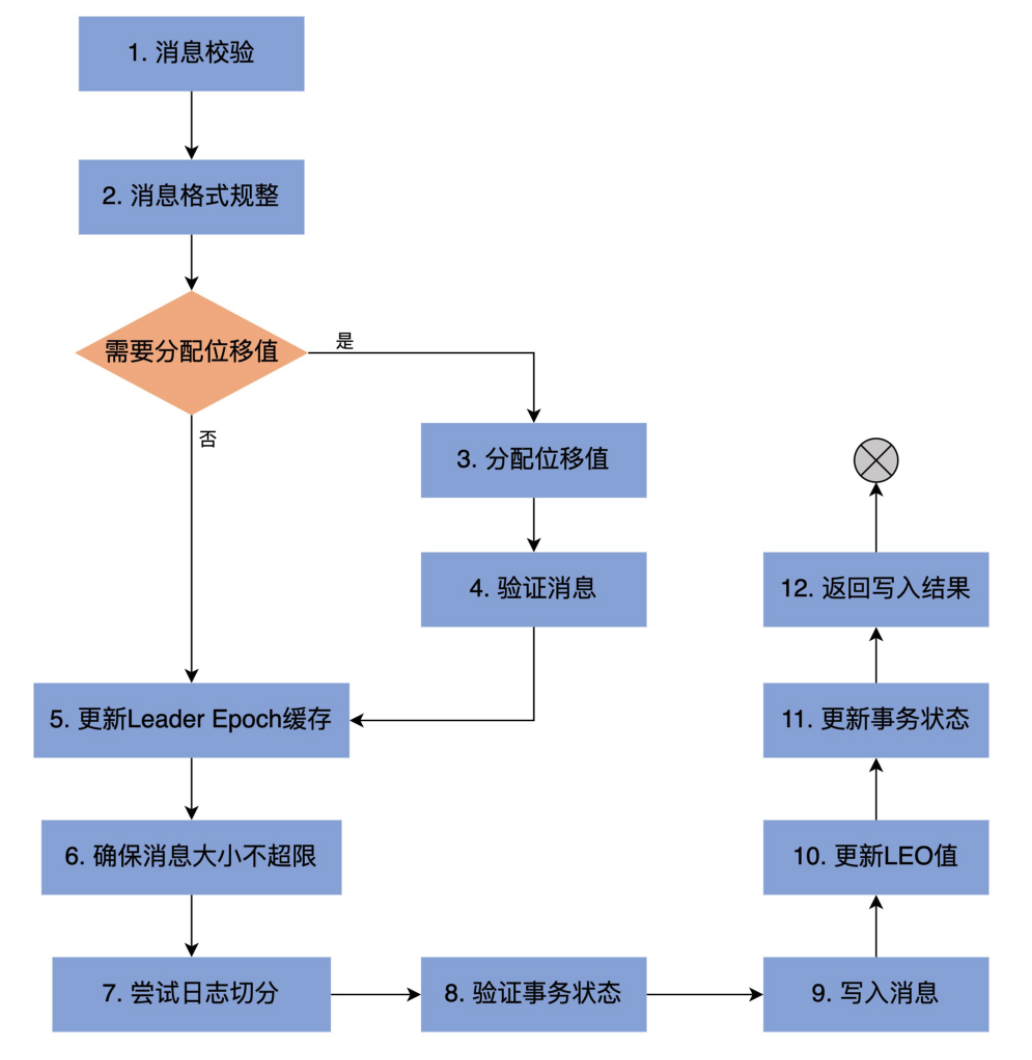上一篇文章講了LogSegment和Log的初始化,這篇來講講Log的主要操作有哪些。
一般來說Log 的常見操作分為 4 大部分。
- 高水位管理操作
- 日誌段管理
- 關鍵位移值管理
- 讀寫操作
其中關鍵位移值管理主要包含Log Start Offset 和 LEO等。
高水位HighWatermark
高水位HighWatermark初始化
高水位是通過LogOffsetMetadata類來定義的:
@volatile private var highWatermarkMetadata: LogOffsetMetadata = LogOffsetMetadata(logStartOffset)
這裏傳入的初始值是logStartOffset,表明當首次構建高水位時,它會被賦值成 Log Start Offset 值。
我們再來看看LogOffsetMetadata類:
case class LogOffsetMetadata(messageOffset: Long,
segmentBaseOffset: Long = Log.UnknownOffset,
relativePositionInSegment: Int = LogOffsetMetadata.UnknownFilePosition) {
// check if this offset is already on an older segment compared with the given offset
def onOlderSegment(that: LogOffsetMetadata): Boolean = {
if (messageOffsetOnly)
throw new KafkaException(s"$this cannot compare its segment info with $that since it only has message offset info")
this.segmentBaseOffset < that.segmentBaseOffset
}
...
}
LogOffsetMetadata有三個初始值:
messageOffset表示消息位移值;
segmentBaseOffset保存消息位移值所在日誌段的起始位移,用來判斷兩條消息是否處於同一個日誌段的;
relativePositionSegment保存消息位移值所在日誌段的物理磁盤位置;
上面的onOlderSegment表明,要比較哪個日誌段更老,只需要比較segmentBaseOffset的大小就可以了。
高水位HighWatermark設值與更新
private def updateHighWatermarkMetadata(newHighWatermark: LogOffsetMetadata): Unit = {
//高水位的值不可能小於零
if (newHighWatermark.messageOffset < 0)
throw new IllegalArgumentException("High watermark offset should be non-negative")
lock synchronized {// 保護Log對象修改的Monitor鎖
highWatermarkMetadata = newHighWatermark// 賦值新的高水位值
//事務相關,暫時忽略
producerStateManager.onHighWatermarkUpdated(newHighWatermark.messageOffset)
//事務相關,暫時忽略
maybeIncrementFirstUnstableOffset()
}
trace(s"Setting high watermark $newHighWatermark")
}
設置高水位的值是很簡單的,首先校驗高水位的值是否大於零,然後通過直接加鎖之後更新高水位的值。
更新更新高水位值的方法有兩個:updateHighWatermark 和 maybeIncrementHighWatermark,我們分別分析。
updateHighWatermark
def updateHighWatermark(hw: Long): Long = {
//傳入的高水位的值如果小於logStartOffset,設置為logStartOffset
val newHighWatermark = if (hw < logStartOffset)
logStartOffset
// 傳入的高水位的值如果大於LEO,那麼設置為LEO
else if (hw > logEndOffset)
logEndOffset
else
hw
//將newHighWatermark封裝成一個LogOffsetMetadata然後更新高水位的值
updateHighWatermarkMetadata(LogOffsetMetadata(newHighWatermark))
//返回新的高水位的值
newHighWatermark
}
這個方法邏輯也很簡潔,因為高水位的值是不可能大於LEO,也不可能小於logStartOffset,所以需要對傳入的hw校驗然後設置成正確的值,然後調用上面的設置高水位的方法設值。
maybeIncrementHighWatermark
/**
* Update the high watermark to a new value if and only if it is larger than the old value. It is
* an error to update to a value which is larger than the log end offset.
*
* This method is intended to be used by the leader to update the high watermark after follower
* fetch offsets have been updated.
*
* @return the old high watermark, if updated by the new value
*/
// 當新的高水位的值大於舊的高水位的值時才做更新,如果新的高水位的值大於LEO,會報錯
// 這個方法是leader在確認Follower已經拉取了日誌之後才做更新
def maybeIncrementHighWatermark(newHighWatermark: LogOffsetMetadata): Option[LogOffsetMetadata] = {
//如果新的高水位的值大於LEO,會報錯
if (newHighWatermark.messageOffset > logEndOffset)
throw new IllegalArgumentException(s"High watermark $newHighWatermark update exceeds current " +
s"log end offset $logEndOffsetMetadata")
lock.synchronized {
// 獲取老的高水位值
val oldHighWatermark = fetchHighWatermarkMetadata
// Ensure that the high watermark increases monotonically. We also update the high watermark when the new
// offset metadata is on a newer segment, which occurs whenever the log is rolled to a new segment.
//只有當新的高水位值大於老的值,因為要維護高水位的單調遞增性
//或者當新的高水位值和老的高水位值相等,但是新的高水位在一個新的日誌段上面時才做更新
if (oldHighWatermark.messageOffset < newHighWatermark.messageOffset ||
(oldHighWatermark.messageOffset == newHighWatermark.messageOffset && oldHighWatermark.onOlderSegment(newHighWatermark))) {
updateHighWatermarkMetadata(newHighWatermark)
Some(oldHighWatermark)// 返回老的高水位值
} else {
None
}
}
}
這個方法我將這個方法的英文註釋貼出來了,這個註釋的說明我也寫到方法上了,邏輯很清楚,大家看看註釋應該能理解。
這兩個方法主要的區別是,updateHighWatermark 方法,主要用在 Follower 副本從 Leader 副本獲取到消息后更新高水位值。而 maybeIncrementHighWatermark 方法,主要是用來更新 Leader 副本的高水位值。
上面的方法中通過調用fetchHighWatermarkMetadata來獲取高水位的值,我們下面看看這個方法:
fetchHighWatermarkMetadata
private def fetchHighWatermarkMetadata: LogOffsetMetadata = {
// 讀取時確保日誌不能被關閉
checkIfMemoryMappedBufferClosed()
val offsetMetadata = highWatermarkMetadata
if (offsetMetadata.messageOffsetOnly) {//沒有獲得到完整的高水位元數據
lock.synchronized {
// 通過讀日誌文件的方式把完整的高水位元數據信息拉出來
val fullOffset = convertToOffsetMetadataOrThrow(highWatermark)
updateHighWatermarkMetadata(fullOffset)
fullOffset
}
} else {
offsetMetadata
}
}
private def convertToOffsetMetadataOrThrow(offset: Long): LogOffsetMetadata = {
//通過給的offset,去日誌文件中找到相應的日誌信息
val fetchDataInfo = read(offset,
maxLength = 1,
isolation = FetchLogEnd,
minOneMessage = false)
fetchDataInfo.fetchOffsetMetadata
}
然後我們提前看一下日誌的read方法,是如何根據索引讀取數據的:
日誌段操作
日誌讀取操作
read
def read(startOffset: Long,
maxLength: Int,
isolation: FetchIsolation,
minOneMessage: Boolean): FetchDataInfo = {
maybeHandleIOException(s"Exception while reading from $topicPartition in dir ${dir.getParent}") {
trace(s"Reading $maxLength bytes from offset $startOffset of length $size bytes")
//convertToOffsetMetadataOrThrow傳進來是FetchLogEnd,所以這裡是false
val includeAbortedTxns = isolation == FetchTxnCommitted
// 由於沒有使用鎖,所以使用變量緩存當前的nextOffsetMetadata狀態
val endOffsetMetadata = nextOffsetMetadata
val endOffset = endOffsetMetadata.messageOffset
// 到日字段中根據索引尋找最近的日誌段
var segmentEntry = segments.floorEntry(startOffset)
// return error on attempt to read beyond the log end offset or read below log start offset
// 這裏給出了幾種異常場景:
// 1. 給的日誌索引大於最大值;
// 2. 通過索引找的日誌段為空;
// 3. 給的日誌索引小於logStartOffset
if (startOffset > endOffset || segmentEntry == null || startOffset < logStartOffset)
throw new OffsetOutOfRangeException(s"Received request for offset $startOffset for partition $topicPartition, " +
s"but we only have log segments in the range $logStartOffset to $endOffset.")
//convertToOffsetMetadataOrThrow傳進來是FetchLogEnd,所以最大值是endOffsetMetadata
// 查看一下讀取隔離級別設置。
// 普通消費者能夠看到[Log Start Offset, LEO)之間的消息
// 事務型消費者只能看到[Log Start Offset, Log Stable Offset]之間的消息。Log Stable Offset(LSO)是比LEO值小的位移值,為Kafka事務使用
// Follower副本消費者能夠看到[Log Start Offset,高水位值]之間的消息
val maxOffsetMetadata = isolation match {
case FetchLogEnd => endOffsetMetadata
case FetchHighWatermark => fetchHighWatermarkMetadata
case FetchTxnCommitted => fetchLastStableOffsetMetadata
}
//如果尋找的索引等於maxOffsetMetadata,那麼直接返回
if (startOffset == maxOffsetMetadata.messageOffset) {
return emptyFetchDataInfo(maxOffsetMetadata, includeAbortedTxns)
//如果尋找的索引大於maxOffsetMetadata,返回空的消息集合,因為沒法讀取任何消息
} else if (startOffset > maxOffsetMetadata.messageOffset) {
val startOffsetMetadata = convertToOffsetMetadataOrThrow(startOffset)
return emptyFetchDataInfo(startOffsetMetadata, includeAbortedTxns)
}
// 開始遍曆日志段對象,直到讀出東西來或者讀到日誌末尾
while (segmentEntry != null) {
val segment = segmentEntry.getValue
// 找到日誌段中最大的日誌位移
val maxPosition = {
if (maxOffsetMetadata.segmentBaseOffset == segment.baseOffset) {
maxOffsetMetadata.relativePositionInSegment
} else {
segment.size
}
}
// 根據位移信息從日誌段中讀取日誌信息
val fetchInfo = segment.read(startOffset, maxLength, maxPosition, minOneMessage)
// 如果找不到日誌信息,那麼去日誌段集合中找更大的日誌位移的日誌段
if (fetchInfo == null) {
segmentEntry = segments.higherEntry(segmentEntry.getKey)
} else {
return if (includeAbortedTxns)
addAbortedTransactions(startOffset, segmentEntry, fetchInfo)
else
fetchInfo
}
}
//找了所有日誌段的位移依然找不到,這可能是因為大於指定的日誌位移的消息都被刪除了,這種情況返回空
FetchDataInfo(nextOffsetMetadata, MemoryRecords.EMPTY)
}
}
read方法,有四個參數,分別是:
- startOffset:讀取的日誌索引位置。
- maxLength:讀取數據量長度。
- isolation:隔離級別,多用於 Kafka 事務。
- minOneMessage:是否至少返回一條消息。設想如果消息很大,超過了 maxLength,正常情況下 read 方法永遠不會返回任何消息。但如果設置了該參數為 true,read 方法就保證至少能夠返回一條消息。
代碼中使用了segments,來根據位移查找日誌段:
private val segments: ConcurrentNavigableMap[java.lang.Long, LogSegment] = new ConcurrentSkipListMap[java.lang.Long, LogSegment]
我們下面看看read方法具體做了哪些事:
- 由於沒有使用鎖,所以使用變量緩存當前的nextOffsetMetadata狀態,作為最大索引LEO;
- 去日誌段集合里尋找小於或等於指定索引的日誌段;
- 校驗異常情況:
- startOffset是不是超過了LEO;
- 是不是日誌段集合里沒有索引小於startOffset;
- startOffset小於Log Start Offset;
- 接下來獲取一下隔離級別;
- 如果尋找的索引等於LEO,那麼返回空;
- 如果尋找的索引大於LEO,返回空的消息集合,因為沒法讀取任何消息;
- 開始遍曆日志段對象,直到讀出東西來或者讀到日誌末尾;
- 首先找到日誌段中最大的位置;
- 根據位移信息從日誌段中讀取日誌信息(這個read方法我們上一篇已經講解過了);
- 如果找不到日誌信息,那麼讀取日誌段集合中下一個日誌段;
- 找了所有日誌段的位移依然找不到,這可能是因為大於指定的日誌位移的消息都被刪除了,這種情況返回空;
我們在上面的read操作中可以看到,使用了segments來查找日誌。我們主要看看刪除操作
刪除日誌
刪除日誌的入口是:deleteOldSegments
// 如果topic deletion開關是打開的,那麼會刪去過期的日誌段以及超過設置保留日誌大小的日誌
// 無論是否開啟刪除規則,都會刪除在log start offset之前的日誌段
def deleteOldSegments(): Int = {
if (config.delete) {
deleteRetentionMsBreachedSegments() + deleteRetentionSizeBreachedSegments() + deleteLogStartOffsetBreachedSegments()
} else {
deleteLogStartOffsetBreachedSegments()
}
}
deleteOldSegments方法會判斷是否開啟刪除規則,如果開啟,那麼會分別調用:
deleteRetentionMsBreachedSegments刪除segment的時間戳超過了設置時間的日誌段;
deleteRetentionSizeBreachedSegments刪除日誌段空間超過設置空間大小的日誌段;
deleteLogStartOffsetBreachedSegments刪除日誌段的baseOffset小於logStartOffset的日誌段;
我這裏列舉一下這三個方法主要是怎麼實現的:
private def deleteRetentionMsBreachedSegments(): Int = {
if (config.retentionMs < 0) return 0
val startMs = time.milliseconds
//調用deleteOldSegments方法,並傳入匿名函數,判斷當前的segment的時間戳是否超過了設置時間
deleteOldSegments((segment, _) => startMs - segment.largestTimestamp > config.retentionMs,
reason = s"retention time ${config.retentionMs}ms breach")
}
private def deleteRetentionSizeBreachedSegments(): Int = {
if (config.retentionSize < 0 || size < config.retentionSize) return 0
var diff = size - config.retentionSize
//判斷日誌段空間是否超過設置空間大小
//shouldDelete函數會將傳入的日誌段去減diff,直到小於等於零
def shouldDelete(segment: LogSegment, nextSegmentOpt: Option[LogSegment]) = {
if (diff - segment.size >= 0) {
diff -= segment.size
true
} else {
false
}
}
deleteOldSegments(shouldDelete, reason = s"retention size in bytes ${config.retentionSize} breach")
}
private def deleteLogStartOffsetBreachedSegments(): Int = {
//shouldDelete函數主要判斷日誌段的baseOffset是否小於logStartOffset
def shouldDelete(segment: LogSegment, nextSegmentOpt: Option[LogSegment]) =
nextSegmentOpt.exists(_.baseOffset <= logStartOffset)
deleteOldSegments(shouldDelete, reason = s"log start offset $logStartOffset breach")
}
這種寫代碼的方式非常的靈活,通過不同方法設置不同的函數來實現代碼復用的目的,最後都是通過調用deleteOldSegments來實現刪除日誌段的目的。
下面我們來看一下deleteOldSegments的操作:
deleteOldSegments
這個deleteOldSegments方法和上面的入口方法傳入的參數是不一致的,這個方法傳入了一個predicate函數,用於判斷哪些日誌段是可以被刪除的,reason用來說明被刪除的原因。
private def deleteOldSegments(predicate: (LogSegment, Option[LogSegment]) => Boolean, reason: String): Int = {
//刪除任何匹配到predicate規則的日誌段
lock synchronized {
val deletable = deletableSegments(predicate)
if (deletable.nonEmpty)
info(s"Found deletable segments with base offsets [${deletable.map(_.baseOffset).mkString(",")}] due to $reason")
deleteSegments(deletable)
}
}
這個方法調用了兩個主要的方法,一個是deletableSegments,用於獲取可以被刪除的日誌段的集合;deleteSegments用於刪除日誌段。
deletableSegments
private def deletableSegments(predicate: (LogSegment, Option[LogSegment]) => Boolean): Iterable[LogSegment] = {
//如果日誌段是空的,那麼直接返回
if (segments.isEmpty) {
Seq.empty
} else {
val deletable = ArrayBuffer.empty[LogSegment]
var segmentEntry = segments.firstEntry
//如果日誌段集合不為空,找到第一個日誌段
while (segmentEntry != null) {
val segment = segmentEntry.getValue
//獲取下一個日誌段
val nextSegmentEntry = segments.higherEntry(segmentEntry.getKey)
val (nextSegment, upperBoundOffset, isLastSegmentAndEmpty) = if (nextSegmentEntry != null)
(nextSegmentEntry.getValue, nextSegmentEntry.getValue.baseOffset, false)
else
(null, logEndOffset, segment.size == 0)
//如果下一個日誌段的位移沒有大於或等於HW,並且日誌段是匹配predicate函數的,下一個日誌段也不是空的
//那麼將這個日誌段放入可刪除集合中,然後遍歷下一個日誌段
if (highWatermark >= upperBoundOffset && predicate(segment, Option(nextSegment)) && !isLastSegmentAndEmpty) {
deletable += segment
segmentEntry = nextSegmentEntry
} else {
segmentEntry = null
}
}
deletable
}
}
這個方法邏輯十分清晰,主要做了如下幾件事:
-
判斷日誌段集合是否為空,為空那麼直接返回空集合;
-
如果日誌段集合不為空,那麼從日誌段集合的第一個日誌段開始遍歷;
-
判斷當前被遍曆日志段是否能夠被刪除
- 日誌段的下一個日誌段的位移有沒有大於或等於HW;
- 日誌段是否能夠通過predicate函數校驗;
- 日誌段是否是最後一個日誌段;
-
將符合條件的日誌段都加入到deletable集合中,並返回。
接下來調用deleteSegments函數:
private def deleteSegments(deletable: Iterable[LogSegment]): Int = {
maybeHandleIOException(s"Error while deleting segments for $topicPartition in dir ${dir.getParent}") {
val numToDelete = deletable.size
if (numToDelete > 0) {
// we must always have at least one segment, so if we are going to delete all the segments, create a new one first
// 我們至少保證要存在一個日誌段,如果要刪除所有的日誌;
//所以調用roll方法創建一個全新的日誌段對象,並且關閉當前寫入的日誌段對象;
if (segments.size == numToDelete)
roll()
lock synchronized {
// 確保Log對象沒有被關閉
checkIfMemoryMappedBufferClosed()
// remove the segments for lookups
// 刪除給定的日誌段對象以及底層的物理文件
removeAndDeleteSegments(deletable, asyncDelete = true)
// 嘗試更新日誌的Log Start Offset值
maybeIncrementLogStartOffset(segments.firstEntry.getValue.baseOffset)
}
}
numToDelete
}
}
寫日誌
寫日誌的方法主要有兩個:
appendAsLeader
def appendAsLeader(records: MemoryRecords, leaderEpoch: Int, isFromClient: Boolean = true,
interBrokerProtocolVersion: ApiVersion = ApiVersion.latestVersion): LogAppendInfo = {
append(records, isFromClient, interBrokerProtocolVersion, assignOffsets = true, leaderEpoch)
}
appendAsFollower
def appendAsFollower(records: MemoryRecords): LogAppendInfo = {
append(records, isFromClient = false, interBrokerProtocolVersion = ApiVersion.latestVersion, assignOffsets = false, leaderEpoch = -1)
}
appendAsLeader 是用於寫 Leader 副本的,appendAsFollower 是用於 Follower 副本同步的。它們的底層都調用了 append 方法
append
private def append(records: MemoryRecords, isFromClient: Boolean, interBrokerProtocolVersion: ApiVersion, assignOffsets: Boolean, leaderEpoch: Int): LogAppendInfo = {
maybeHandleIOException(s"Error while appending records to $topicPartition in dir ${dir.getParent}") {
// 第1步:分析和驗證待寫入消息集合,並返回校驗結果
val appendInfo = analyzeAndValidateRecords(records, isFromClient = isFromClient)
// return if we have no valid messages or if this is a duplicate of the last appended entry
// 如果壓根就不需要寫入任何消息,直接返回即可
if (appendInfo.shallowCount == 0)
return appendInfo
// trim any invalid bytes or partial messages before appending it to the on-disk log
// 第2步:消息格式規整,即刪除無效格式消息或無效字節
var validRecords = trimInvalidBytes(records, appendInfo)
// they are valid, insert them in the log
lock synchronized {
// 確保Log對象未關閉
checkIfMemoryMappedBufferClosed()
//需要分配位移值
if (assignOffsets) {
// assign offsets to the message set
// 第3步:使用當前LEO值作為待寫入消息集合中第一條消息的位移值,nextOffsetMetadata為LEO值
val offset = new LongRef(nextOffsetMetadata.messageOffset)
appendInfo.firstOffset = Some(offset.value)
val now = time.milliseconds
val validateAndOffsetAssignResult = try {
LogValidator.validateMessagesAndAssignOffsets(validRecords,
topicPartition,
offset,
time,
now,
appendInfo.sourceCodec,
appendInfo.targetCodec,
config.compact,
config.messageFormatVersion.recordVersion.value,
config.messageTimestampType,
config.messageTimestampDifferenceMaxMs,
leaderEpoch,
isFromClient,
interBrokerProtocolVersion,
brokerTopicStats)
} catch {
case e: IOException =>
throw new KafkaException(s"Error validating messages while appending to log $name", e)
}
// 更新校驗結果對象類LogAppendInfo
validRecords = validateAndOffsetAssignResult.validatedRecords
appendInfo.maxTimestamp = validateAndOffsetAssignResult.maxTimestamp
appendInfo.offsetOfMaxTimestamp = validateAndOffsetAssignResult.shallowOffsetOfMaxTimestamp
appendInfo.lastOffset = offset.value - 1
appendInfo.recordConversionStats = validateAndOffsetAssignResult.recordConversionStats
if (config.messageTimestampType == TimestampType.LOG_APPEND_TIME)
appendInfo.logAppendTime = now
// re-validate message sizes if there's a possibility that they have changed (due to re-compression or message
// format conversion)
// 第4步:驗證消息,確保消息大小不超限
if (validateAndOffsetAssignResult.messageSizeMaybeChanged) {
for (batch <- validRecords.batches.asScala) {
if (batch.sizeInBytes > config.maxMessageSize) {
// we record the original message set size instead of the trimmed size
// to be consistent with pre-compression bytesRejectedRate recording
brokerTopicStats.topicStats(topicPartition.topic).bytesRejectedRate.mark(records.sizeInBytes)
brokerTopicStats.allTopicsStats.bytesRejectedRate.mark(records.sizeInBytes)
throw new RecordTooLargeException(s"Message batch size is ${batch.sizeInBytes} bytes in append to" +
s"partition $topicPartition which exceeds the maximum configured size of ${config.maxMessageSize}.")
}
}
}
// 直接使用給定的位移值,無需自己分配位移值
} else {
// we are taking the offsets we are given
if (!appendInfo.offsetsMonotonic)// 確保消息位移值的單調遞增性
throw new OffsetsOutOfOrderException(s"Out of order offsets found in append to $topicPartition: " +
records.records.asScala.map(_.offset))
if (appendInfo.firstOrLastOffsetOfFirstBatch < nextOffsetMetadata.messageOffset) {
// we may still be able to recover if the log is empty
// one example: fetching from log start offset on the leader which is not batch aligned,
// which may happen as a result of AdminClient#deleteRecords()
val firstOffset = appendInfo.firstOffset match {
case Some(offset) => offset
case None => records.batches.asScala.head.baseOffset()
}
val firstOrLast = if (appendInfo.firstOffset.isDefined) "First offset" else "Last offset of the first batch"
throw new UnexpectedAppendOffsetException(
s"Unexpected offset in append to $topicPartition. $firstOrLast " +
s"${appendInfo.firstOrLastOffsetOfFirstBatch} is less than the next offset ${nextOffsetMetadata.messageOffset}. " +
s"First 10 offsets in append: ${records.records.asScala.take(10).map(_.offset)}, last offset in" +
s" append: ${appendInfo.lastOffset}. Log start offset = $logStartOffset",
firstOffset, appendInfo.lastOffset)
}
}
// update the epoch cache with the epoch stamped onto the message by the leader
// 第5步:更新Leader Epoch緩存
validRecords.batches.asScala.foreach { batch =>
if (batch.magic >= RecordBatch.MAGIC_VALUE_V2) {
maybeAssignEpochStartOffset(batch.partitionLeaderEpoch, batch.baseOffset)
} else {
// In partial upgrade scenarios, we may get a temporary regression to the message format. In
// order to ensure the safety of leader election, we clear the epoch cache so that we revert
// to truncation by high watermark after the next leader election.
leaderEpochCache.filter(_.nonEmpty).foreach { cache =>
warn(s"Clearing leader epoch cache after unexpected append with message format v${batch.magic}")
cache.clearAndFlush()
}
}
}
// check messages set size may be exceed config.segmentSize
// 第6步:確保消息大小不超限
if (validRecords.sizeInBytes > config.segmentSize) {
throw new RecordBatchTooLargeException(s"Message batch size is ${validRecords.sizeInBytes} bytes in append " +
s"to partition $topicPartition, which exceeds the maximum configured segment size of ${config.segmentSize}.")
}
// maybe roll the log if this segment is full
// 第7步:執行日誌切分。當前日誌段剩餘容量可能無法容納新消息集合,因此有必要創建一個新的日誌段來保存待寫入的所有消息
//下面情況將會執行日誌切分:
//logSegment 已經滿了
//日誌段中的第一個消息的maxTime已經過期
//index索引滿了
val segment = maybeRoll(validRecords.sizeInBytes, appendInfo)
val logOffsetMetadata = LogOffsetMetadata(
messageOffset = appendInfo.firstOrLastOffsetOfFirstBatch,
segmentBaseOffset = segment.baseOffset,
relativePositionInSegment = segment.size)
// now that we have valid records, offsets assigned, and timestamps updated, we need to
// validate the idempotent/transactional state of the producers and collect some metadata
// 第8步:驗證事務狀態
val (updatedProducers, completedTxns, maybeDuplicate) = analyzeAndValidateProducerState(
logOffsetMetadata, validRecords, isFromClient)
maybeDuplicate.foreach { duplicate =>
appendInfo.firstOffset = Some(duplicate.firstOffset)
appendInfo.lastOffset = duplicate.lastOffset
appendInfo.logAppendTime = duplicate.timestamp
appendInfo.logStartOffset = logStartOffset
return appendInfo
}
// 第9步:執行真正的消息寫入操作,主要調用日誌段對象的append方法實現
segment.append(largestOffset = appendInfo.lastOffset,
largestTimestamp = appendInfo.maxTimestamp,
shallowOffsetOfMaxTimestamp = appendInfo.offsetOfMaxTimestamp,
records = validRecords)
// Increment the log end offset. We do this immediately after the append because a
// write to the transaction index below may fail and we want to ensure that the offsets
// of future appends still grow monotonically. The resulting transaction index inconsistency
// will be cleaned up after the log directory is recovered. Note that the end offset of the
// ProducerStateManager will not be updated and the last stable offset will not advance
// if the append to the transaction index fails.
// 第10步:更新LEO對象,其中,LEO值是消息集合中最後一條消息位移值+1
// 前面說過,LEO值永遠指向下一條不存在的消息
updateLogEndOffset(appendInfo.lastOffset + 1)
// update the producer state
// 第11步:更新事務狀態
for (producerAppendInfo <- updatedProducers.values) {
producerStateManager.update(producerAppendInfo)
}
// update the transaction index with the true last stable offset. The last offset visible
// to consumers using READ_COMMITTED will be limited by this value and the high watermark.
for (completedTxn <- completedTxns) {
val lastStableOffset = producerStateManager.lastStableOffset(completedTxn)
segment.updateTxnIndex(completedTxn, lastStableOffset)
producerStateManager.completeTxn(completedTxn)
}
// always update the last producer id map offset so that the snapshot reflects the current offset
// even if there isn't any idempotent data being written
producerStateManager.updateMapEndOffset(appendInfo.lastOffset + 1)
// update the first unstable offset (which is used to compute LSO)
maybeIncrementFirstUnstableOffset()
trace(s"Appended message set with last offset: ${appendInfo.lastOffset}, " +
s"first offset: ${appendInfo.firstOffset}, " +
s"next offset: ${nextOffsetMetadata.messageOffset}, " +
s"and messages: $validRecords")
// 是否需要手動落盤。一般情況下我們不需要設置Broker端參數log.flush.interval.messages
// 落盤操作交由操作系統來完成。但某些情況下,可以設置該參數來確保高可靠性
if (unflushedMessages >= config.flushInterval)
flush()
// 第12步:返回寫入結果
appendInfo
}
}
}
上面代碼的主要步驟如下:
我們下面看看analyzeAndValidateRecords是如何進行消息校驗的:
analyzeAndValidateRecords
private def analyzeAndValidateRecords(records: MemoryRecords, isFromClient: Boolean): LogAppendInfo = {
var shallowMessageCount = 0
var validBytesCount = 0
var firstOffset: Option[Long] = None
var lastOffset = -1L
var sourceCodec: CompressionCodec = NoCompressionCodec
var monotonic = true
var maxTimestamp = RecordBatch.NO_TIMESTAMP
var offsetOfMaxTimestamp = -1L
var readFirstMessage = false
var lastOffsetOfFirstBatch = -1L
for (batch <- records.batches.asScala) {
// we only validate V2 and higher to avoid potential compatibility issues with older clients
// 消息格式Version 2的消息批次,起始位移值必須從0開始
if (batch.magic >= RecordBatch.MAGIC_VALUE_V2 && isFromClient && batch.baseOffset != 0)
throw new InvalidRecordException(s"The baseOffset of the record batch in the append to $topicPartition should " +
s"be 0, but it is ${batch.baseOffset}")
// update the first offset if on the first message. For magic versions older than 2, we use the last offset
// to avoid the need to decompress the data (the last offset can be obtained directly from the wrapper message).
// For magic version 2, we can get the first offset directly from the batch header.
// When appending to the leader, we will update LogAppendInfo.baseOffset with the correct value. In the follower
// case, validation will be more lenient.
// Also indicate whether we have the accurate first offset or not
if (!readFirstMessage) {
if (batch.magic >= RecordBatch.MAGIC_VALUE_V2)
firstOffset = Some(batch.baseOffset) // 更新firstOffset字段
lastOffsetOfFirstBatch = batch.lastOffset // 更新lastOffsetOfFirstBatch字段
readFirstMessage = true
}
// check that offsets are monotonically increasing
// 一旦出現當前lastOffset不小於下一個batch的lastOffset,說明上一個batch中有消息的位移值大於後面batch的消息
// 這違反了位移值單調遞增性
if (lastOffset >= batch.lastOffset)
monotonic = false
// update the last offset seen
// 使用當前batch最後一條消息的位移值去更新lastOffset
lastOffset = batch.lastOffset
// Check if the message sizes are valid.
val batchSize = batch.sizeInBytes
// 檢查消息批次總字節數大小是否超限,即是否大於Broker端參數max.message.bytes值
if (batchSize > config.maxMessageSize) {
brokerTopicStats.topicStats(topicPartition.topic).bytesRejectedRate.mark(records.sizeInBytes)
brokerTopicStats.allTopicsStats.bytesRejectedRate.mark(records.sizeInBytes)
throw new RecordTooLargeException(s"The record batch size in the append to $topicPartition is $batchSize bytes " +
s"which exceeds the maximum configured value of ${config.maxMessageSize}.")
}
// check the validity of the message by checking CRC
// 執行消息批次校驗,包括格式是否正確以及CRC校驗
if (!batch.isValid) {
brokerTopicStats.allTopicsStats.invalidMessageCrcRecordsPerSec.mark()
throw new CorruptRecordException(s"Record is corrupt (stored crc = ${batch.checksum()}) in topic partition $topicPartition.")
}
// 更新maxTimestamp字段和offsetOfMaxTimestamp
if (batch.maxTimestamp > maxTimestamp) {
maxTimestamp = batch.maxTimestamp
offsetOfMaxTimestamp = lastOffset
}
// 累加消息批次計數器以及有效字節數,更新shallowMessageCount字段
shallowMessageCount += 1
validBytesCount += batchSize
// 從消息批次中獲取壓縮器類型
val messageCodec = CompressionCodec.getCompressionCodec(batch.compressionType.id)
if (messageCodec != NoCompressionCodec)
sourceCodec = messageCodec
}
// Apply broker-side compression if any
// 獲取Broker端設置的壓縮器類型,即Broker端參數compression.type值。
// 該參數默認值是producer,表示sourceCodec用的什麼壓縮器,targetCodec就用什麼
val targetCodec = BrokerCompressionCodec.getTargetCompressionCodec(config.compressionType, sourceCodec)
// 最後生成LogAppendInfo對象並返回
LogAppendInfo(firstOffset, lastOffset, maxTimestamp, offsetOfMaxTimestamp, RecordBatch.NO_TIMESTAMP, logStartOffset,
RecordConversionStats.EMPTY, sourceCodec, targetCodec, shallowMessageCount, validBytesCount, monotonic, lastOffsetOfFirstBatch)
}
本站聲明:網站內容來源於博客園,如有侵權,請聯繫我們,我們將及時處理
【其他文章推薦】
※廣告預算用在刀口上,台北網頁設計公司幫您達到更多曝光效益
※新北清潔公司,居家、辦公、裝潢細清專業服務
※別再煩惱如何寫文案,掌握八大原則!
※教你寫出一流的銷售文案?
※超省錢租車方案
※FB行銷專家,教你從零開始的技巧





 沙耶武里水壩即將完工。照片來源:
沙耶武里水壩即將完工。照片來源:  沙耶武里水壩開發前的地景樣貌。照片來源: (CC BY 2.0)
沙耶武里水壩開發前的地景樣貌。照片來源: (CC BY 2.0) 